Northrop F-89 Scorpion American Fighter Interceptor (2 Part) Tests and Applications
In October, Muroc conducted comparative tests of three competitors: Curtiss XF-87, Northrop XF-89 and Douglas XF3D-1 (the option proposed by Douglas was an all-weather deck-based interceptor for the Navy, but the company also tried to interest it with the air force , which naturally caused a negative reaction from the management fleetwho financed the construction of XF3D-1).
Aircraft crews took part in the comparative tests of the aircraft - three pilots, an operator and a technician each, who were to choose the best interceptor. Both ground and flight crews in the first place were unanimously placed by Douglas XF3D-1, the second was Curtiss XF-87, well, the last “Scorpion”. However, a special evaluation committee consisting of 11 high-ranking air force officers, after studying the test materials for serial construction, opposite the Northrop aircraft preferred.
The Curtiss company by that time had a preliminary agreement for the release of the first 88 F-87A "Blackhawk". This agreement was annulled in November 1948, because the Scorpion received a start in life.
The Douglas aircraft became the serial F3D1 Skyline, having entered the deck service aviation.
On the first prototype of the XF-89, which started the flight program of the wingtip tests, there were no fuel tanks. The wingspan in this layout was 15,85 m, and its area - 56,30 m2. An experienced “Scorpion” at ground level reached a speed of 969 km / h, and at an altitude of 10688 meters - 863 km / h. To gain this height, the interceptor needed a little more than 20 minutes.
After the 4542-liter tanks were installed at the ending, the rate of climb dropped (the height of 8077 meters was gained in 21,6 minutes), but the range increased to 1323 km.
At the end of 1948, the first XF-89, after 32's flights in Muroc, received new steering surfaces instead of classical ailerons. The plane returned to the runway 1 February 1949 of the year. The test program before 27 June 1949, the year passed without incident. During 64-th flight at low altitude and high speed problems with control. The pilot was able to cope with malfunctions and made an emergency landing. In this case, the fuselage received minor damage and the chassis was broken. However, this accident did not affect the further fate of the Scorpion, since in May, Northrop entered into an agreement to build a second prototype in a pre-production modified version of the YF-89A and to produce the 48 serial F-89A.
October 15 1949 year repaired after the accident XF-89 started to fly. 22 February 1950 of the year during the 102-th flight, this car crashed. The cause of the crash was the destruction of the tail plumage as a result of flutter provoked by jet engines. In the design of the tail assembly had to urgently make changes. On the YF-89A, as well as on all the serial "Scorpion" installed external balancing weights.
From the prototype serial machines differed and a number of other improvements. On airplanes, starting with the YF-89A, Allison J35-A-21 engines with 2268 kgf thrust and an afterburner chamber were installed. The length of the aircraft due to the increased nose reached 16,31 meters. The volume of fuel tanks at the wing tips was reduced to 1136 liters.
September 28 1950, the first serial F-89A took off. However, the Air Force Command, still under the impression of the prototype catastrophe, was in no hurry to accept the aircraft. The Northrop was forced to conduct extensive tests of production aircraft. The 6 of the X-NUMX of the F-18A Scorpion (the initial order of the 89 machines was reduced to 48) was thoroughly tested by the air force. Three "Scorpion" simultaneously with the flutter flights passed service tests. On the 18 aircraft, the tactics of using the new interceptor were tested.
During these numerous and intense tests, various changes were made to the design. Thus, the aircraft appeared F89B "Scorpion", which was planned as the most popular option for the Air Force. This modification of the first flight made 2 May 1951 of the year. It was different from the F-89A with the new Lear F5 autopilot and improved equipment, but with the preservation of the AN / ARG-33 locator.
The original contract was to make 64 copies of F-89B. Soon followed by an order for another 100 aircraft, but all the machines of the second batch were already released in the modification F-89C. If the F-89А / В got rid of flutter using special weights installed on the stabilizer outside, then on the “C” modification the loads were inside, which did not reduce aerodynamics. The F89C pilot, if necessary, could reset the fuel tanks located at the ends of the wing (in the first versions this possibility was absent). The fuel system and air conditioning system have become more advanced.
In June, the F-1951B Scorpion 89 aircraft entered the 84 th squadron of the 78 th interceptor fighter group (Hamilton), subordinated to the command of air defense. Air defense aviation in the United States is part of the Air Force and does not have a separate status.
Since January, 1952 was retrained to the new F-89C "Scorpion" 74-I squadron.
Over time, the F-89C began to install the modified J35-A-21A engine with a 2313 kgf engine (with an afterburner 3084 kgf), and then J35-A-33 and a three-way engine with more power (thrust without an afterburner 2450 kgf, and with an afterburner 3357 kgf) From the J35-A-33, the A-ZZA engine was distinguished by the presence of an anti-icing system at the entrance and special flaps that protected against the ingress of foreign objects during the taxiing on the runway.
The same engines were installed on the next modification of the “Scorpion” - F-89D. In this version there was a fundamentally different weapon system. The basis of the armament of the F-89D were rockets, which were planned to replace guns with 1945. One hundred and four 70-mm unguided missiles FFAR "Mighty Mouse" with folding plumage were placed in containers at the wingtips (52 pieces each).
The entire volume of this suspension in the early versions of the interceptor occupied the fuel tank. Now, in front of the rocket installed in the guide cylinders, while the amount of fuel was reduced to 1166 liters in each container. Kerosene was separated from the missile compartment by a fire barrier that diverted the jet to the side of the rocket. Instead of guns in the free nose of the fuselage, they put an extra tank with a volume of 992 liters, under the wing on the pylons you could hang two 1136-liter tanks - the total weight of kerosene was 10728 liters.
In April, the 1951 of the year received an order for the 193 of the F-89D instance. After the start of the Korean War, this number was increased to 862 units. - so the F-89D “Scorpion” became the most massive modification. In addition to the purely rocket armament, the machine received the AN / APA-84 fire control computer and the AN / APG-40 radar associated with the autopilot. The new fire control computer allowed launching rockets one by one or in volleys. All 104 "Mighty Mouse" in one volley were fired in less than half a second. The rockets in the two-shot shot were fired in batches of 62 and 42 units, and in the three-split shot - 42, 32 and 30 units.
The US Air Force by November 1952 received the first 5 serial F-89D, but in September, all "Scorpion" were forbidden to take to the air. In the combat units, the operation of the aircraft at first did not cause any complaints. The interceptor had excellent controllability and stability in any weather — the pilots did not experience any particular difficulties in piloting.
February 25 1952, the first F-89C disaster occurred, followed by another five (the last 15 September 1952 g happened). While the causes of the crash were being investigated, the flights of all Scorpion (including the newest F-89D) were stopped. For the Northrop designers, the conclusions made by the flight accident investigation commission were very unpleasant: during rotations with high overload and vigorous turns, the power wing attachment elements to the center wing were destroyed. Weak nodes had to urgently recalculate, and on all aircraft produced to carry out improvements. For this, “Scorpion” was delivered to Los Angeles to the plant, where until January 1954 of the year 94 machines of versions “A” to “C” were upgraded. Due to this unexpected problem, the operation of the interceptor in air defense began with a delay of a year.
Naturally, the F-89D version was also strengthened by the wing, since at the time of the discovery of the cause of the crashes around the 100 aircraft was already on the assembly line. Air Force deliveries of option “D” continued only in January of 1954, when the Scorpion with missile weapons entered the 18 Squadron in Minneapolis. However, the 35 series turbojet engine at an altitude of more than 9 kilometers was not reliable enough - it did not betray the calculated thrust. Soon, these engines were replaced by more advanced J35-A-47. The same engines were installed on all the flying F-89В / С, as well as some F-89D, originally released from the J35-A-35 TRD.
On aircraft F-89D, in addition to problems with the engines, there were difficulties with weapons. In the guides for ATGM penetrated moisture. The resulting corrosion led to several fires and accidents during training launches. Again I had to modify the design: a fairing preventing water ingress was installed on the front of the containers on the containers, which was launched by launching rockets during launch.
Technical problems that appeared during operation did not affect the release of Scorpions. In 1954-1955, the plants of Northrop reached the maximum assembly speed - 25 planes were assembled per month.
It is the turn of the new modification - F-89H. This machine was equipped with the latest Hughes GAR-1 "Falcon" air-to-air missiles. 6 GAR-1 was placed on 3 on each container with the Mighty Mouse. “Falcons” were located on special suspension nodes outside the circumference, while in each container the number of NURSs was reduced to 21 pcs.
27 January 1955 of the year was the first successful training launch of GAR-1: the converted F-89D (designed to test the installation of the new rocket) shot down the unmanned "flying fortress" QB-17. For the effective use of the “Falcons”, a more advanced E-9 OMS was used (the first versions of “Scorpion” were equipped with the E-6 system), which helps the operator to hit the target.
The 445 Squadron (Wurtzmit) received the first serial F-89H in September 1955. By March, 1956, this squadron became the first military unit in the air forces, completely retrained in the "Scorpion".
In 1956, the Scorpion got nuclear weapon - The X-NUMX F-350D aircraft were converted to the F-89J version armed with two CF-89 “Jeni” missiles with atomic warheads (later received the designation AIR-1A). The rockets were hung from below on wing pylons, instead of dropped PTBs. On each plane there were two more pylons serving for the installation of four "Falcons". At the ending only fuel tanks with a capacity of 2 liters were installed. The maximum take-off weight of the F-2271J variant was the highest among all Scorpion - 89 kg.
By February, the 1958 of the year in Los Angeles had completed the conversion to the F-89J version of the serial F-89D. The first "nuclear" aircraft received 84-I squadron (Hamilton).
By 1957, the F-89 aircraft of all the modifications listed above became the main type of interceptor of the air defense command and flew mainly in the North. Fighters except Alaska, based in Iceland (Keflavik) and Greenland (Tula). Served in the northern regions of the "Scorpion" had a corresponding Arctic color. In order for the aircraft to be detected in case of an emergency landing, its tail and half of the planes, together with the containers at the ending, were painted in orange-red color.
In the US Air Force practiced the transfer to aviation of the National Guard of the aircraft. There, machines of various types were mastered by reserve pilots. In addition, the aircraft decommissioned, maintained in a state of alert: they could at any time return to service. In 1954, the pilots of the 176 Squadron, in accordance with the established tradition, first familiarized themselves with the Scorpion of the F-89B modification.
After adopting the newest supersonic interceptors for use in the air force - Conwar F-102A and F-106A and McDonnell F-101B "I Will", the majority of F-89 "Scorpion" turned out in squadrons nat. guard In November, the X-NUMX of the F-1957H was relocated to the base of the 89 squadron (Portland), and in the 123, the F-1958D received the 89-I squadron. By 178, the scorpion piloting, including the F-1962J variant, was mastered by nine units of the National Guard. On the F-89J, the 89-I squadron (Iowa) and 124-I (Maine) flew the longest, where the outdated Scorpion was operated until the 132 of the year. In the Air Force, the F-1969 was removed from service in 89, when military air defense aircraft became supersonic.
Difficulties with TRD J35 forced designers to think about other power plants. On the basis of the F-89C was built flying laboratory YF-89E having as a power plant experienced turbojet engine YJ71-A-3 (thrust 3175 kgf). This modification first rose in the air 10 June 1954 of the year. The mentioned engine was supposed to be used on the F-89F variant, which was significantly different from the serial "Scorpions". In fact, it was a completely different aircraft, having a new roomy fuselage and larger wings with a small sweep. In the middle of the planes, there were two long gondolas that serve to accommodate the fuel and retract the main landing gear. In the front, there were guides for the MNI Maus Mouse 21, and on the gondolas the attachment points for the 6 Falcon missiles.
The development of the F-89F began in the 1952 year, but when the serial Scorpion was faced with a weak wing structure, the air force refused to build it. Only on paper also remained an option F-89G. This modification was basically similar to the “F” version - 2 of the container with 54 NURS FFAR, in the nose it was planned to install 6 guns with 20 caliber mm or ten 12,7-mm machine guns.
The latest attempt to improve the performance of Scorpion was the creation of the F-1954X version in 89. The car was conceived as a radical modification of the F-89D. On the interceptor, it was planned to install Wright J-65 “Sapphire” engines, which would allow increasing the maximum ceiling to 17,4 km. However, in the middle of the 1950's, the subsonic interceptor could no longer be considered promising and did not start flying.
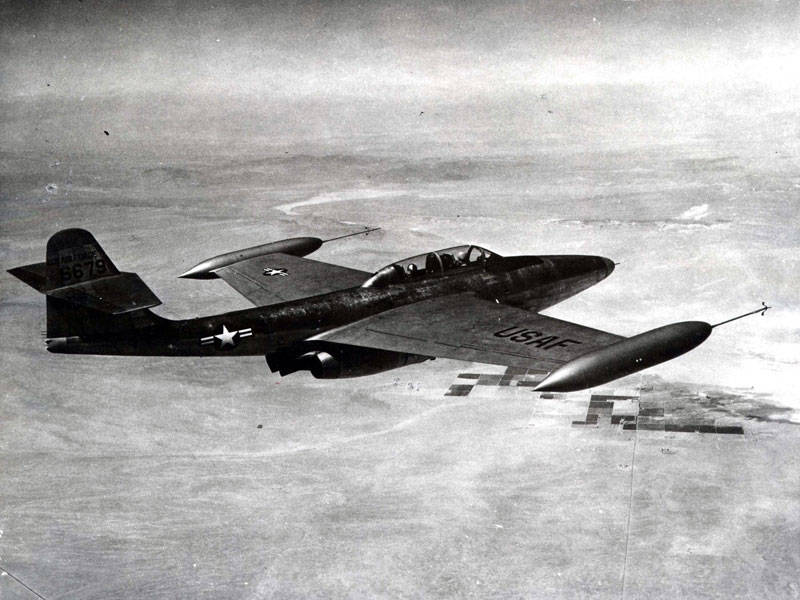
Thus, the F-89 development line ended on F-89X. The total number of modifications released - 1050 aircraft. Despite the various problems that arose during operation, the F-89 "Scorpion" served well. To a certain extent, this aircraft became a symbol of the United States air defense in the early 1950s.
Flight specifications of the Northrop F-89 Scorpion:
Length - 16,4 m;
Height - 5,33 m;
Wingspan - 18,2 m (including blocks NAR at the tips);
Wing area - 60,39 m2;
Sweep wing on the leading edge - 5 ° 8 ';
Wing Profile - NACA 0009-64;
Average aerodynamic chord - 3,7 m;
The coefficient of elongation of the wing - 5,15;
Wing load - 317 kg / m;
Wheel track - 6,68 m;
Empty weight - 11428 kg;
The curb weight of the aircraft - 13082 kg;
Normal take-off weight - 19160 kg;
Maximum take-off weight - 21155 kg;
Maximum landing weight - 17581 kg;
The mass of fuel - 5224 kg (in internal tanks) + 1769 kg (under the wing in the PTB);
Fuel tank capacity - 6708 L (in PTB under the wing 2270 L);
The volume of fuel in the PTB - 2х1135 l (under the wing);
The number of engines - 2;
Powerplant - TRDF Allison J35-A-35;
Single engine - 24,2 kN (unformed);
Normal thrust - 21,6 kN;
Afterburner - 32,0 kN;
Dry weight of the engine - 1293 kg;
The diameter of the engine - 0,94 m;
Engine length - 4,97 m;
Cruising speed - 713 km / h;
Maximum speed - 1032 km / h;
Stall speed at normal take-off mass - 219 km / h;
Combat radius - 615 km;
Combat radius with PTB - 950 km;
Ferrying range - 2200 km;
Practical ceiling - 14783 m;
Rate of climb - 42,47 m / s;
Set time 12192 m - 11,4 min;
Set time 15240 m - 29,2 min;
Thrust-to-0,26 (maximum) / 0,34 (with boost);
Run length - 828 m;
Runway Length - 1036 m;
Maximum operating overload - 5,67 g;
Armament - 104 unguided rocket FFAR caliber 70 mm at the ending;
Crew - 2 man
Based on materials:
http://www.airwar.ru
http://www.dogswar.ru
http://www.combatavia.info
http://www.cofe.ru/avia
- American interceptor fighter Northrop F-89 "Scorpion" (Part of 1) Creation
American fighter-interceptor Northrop F-89 "Scorpion" (Part of 2) tests and applications
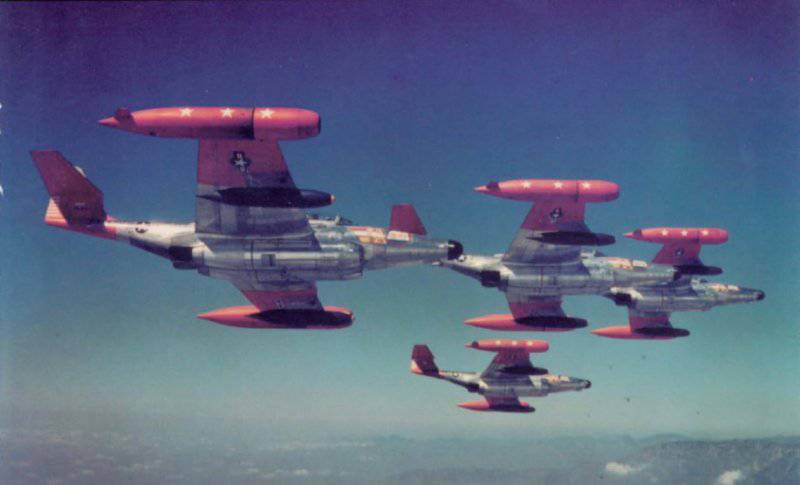
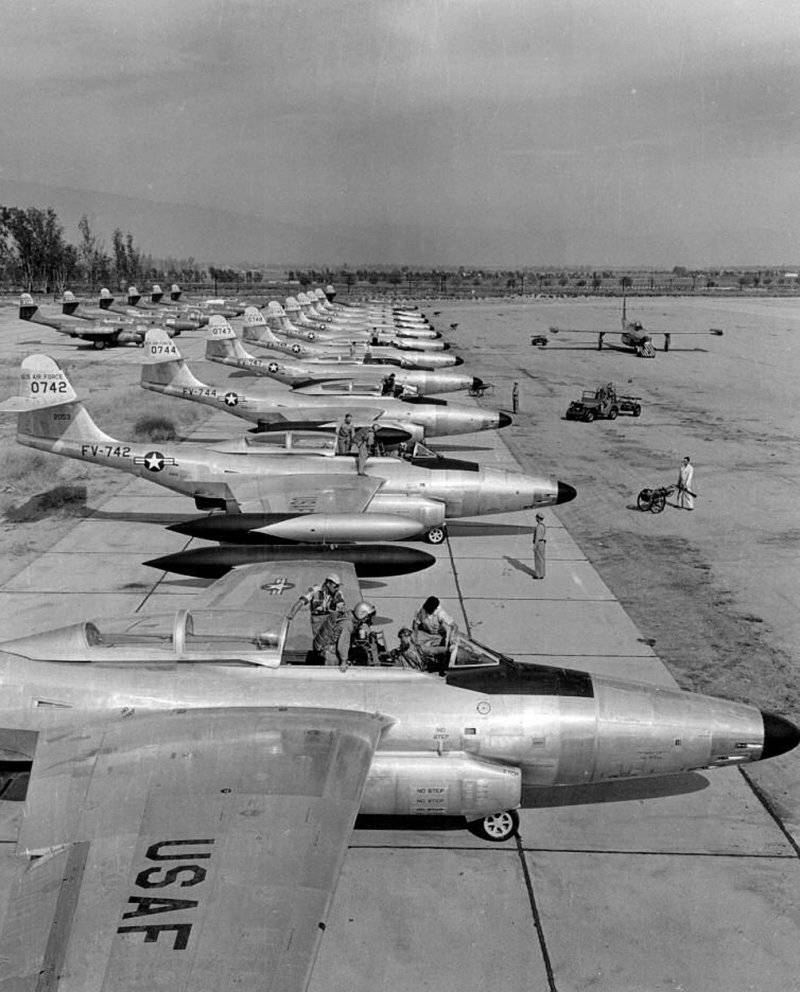
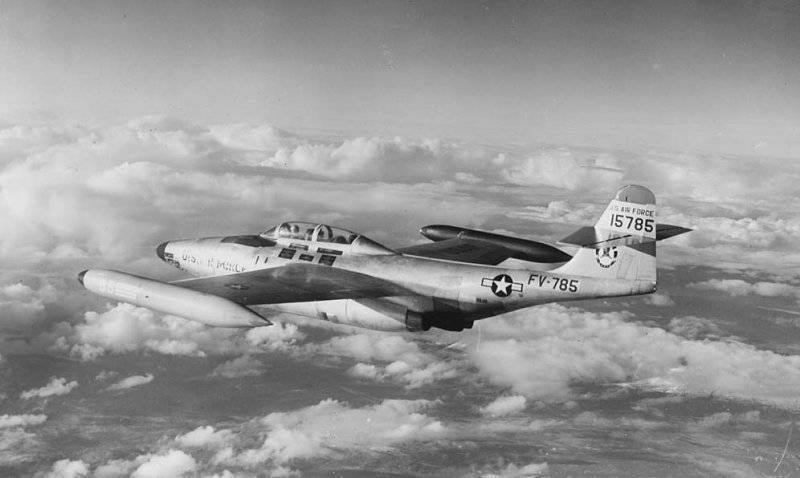
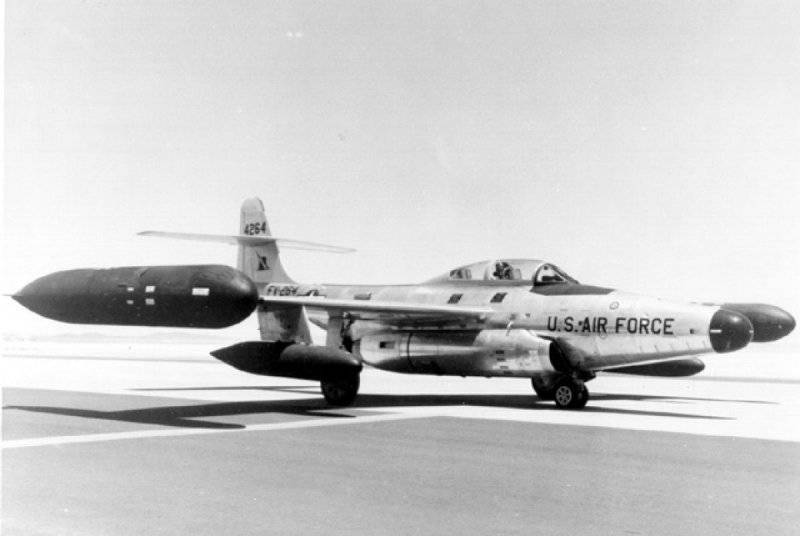
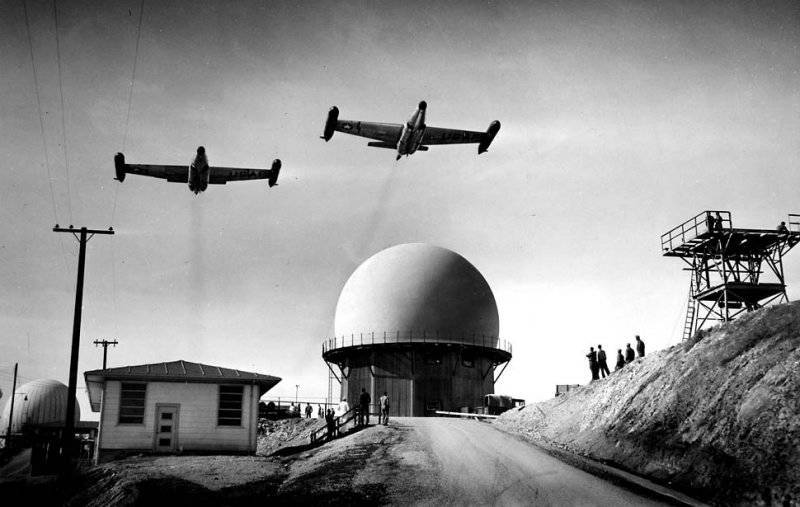
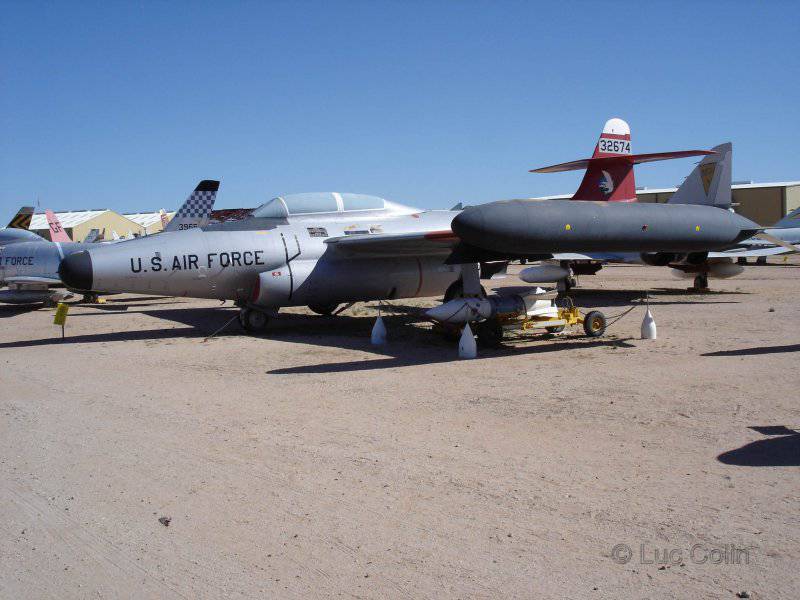
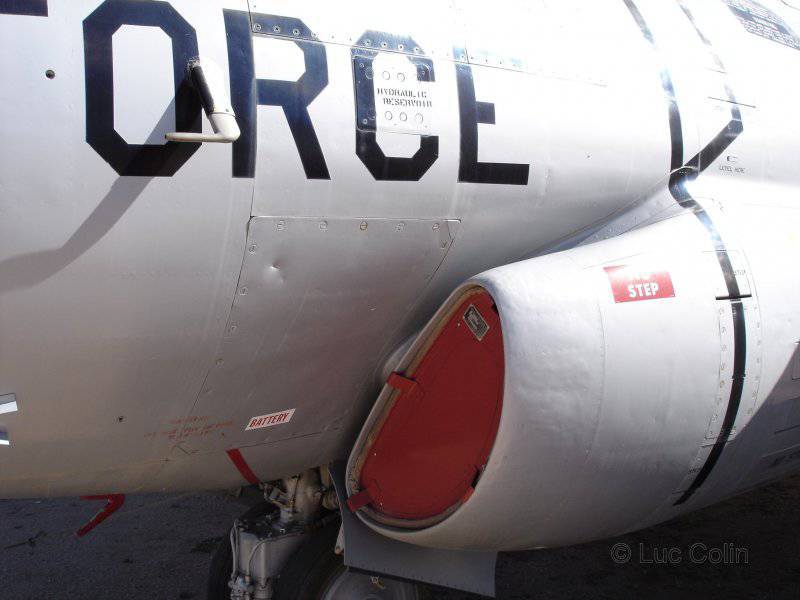
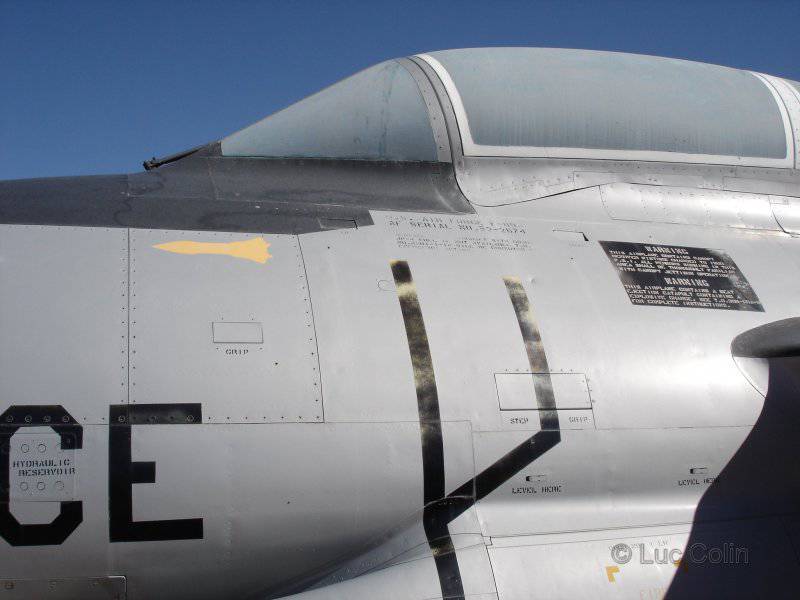
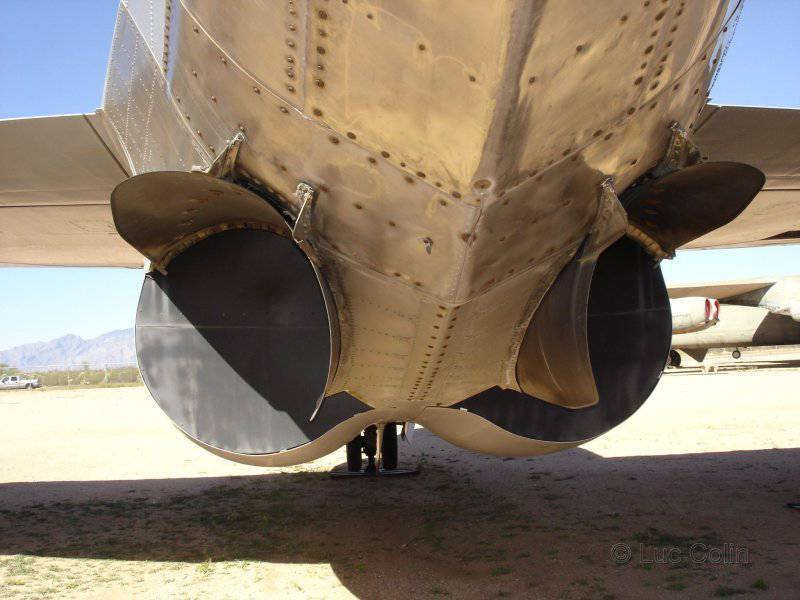
Information